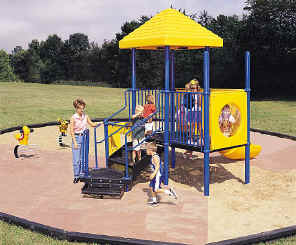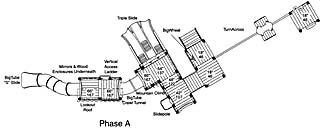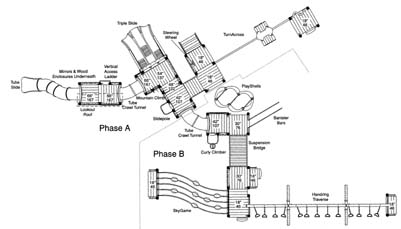Where do the Play Areas Guidelines Apply?
New Construction
The play area guidelines in this guide apply to all newly designed or constructed play areas for children ages 2 and older. This includes play areas located in a variety of settings: parks, schools, childcare facilities, shopping centers, and public gathering areas. Owners or operators of newly constructed play areas are responsible for complying with these guidelines.
The play area guidelines do not apply to:
- Family childcare facilities where the proprietor resides
- Amusement attractions
- Religious entities
Alterations
The play area guidelines apply to alterations made to existing play areas that affect, or could affect, the usability of the play area. Examples include removing a climbing play component and replacing it with a spring rocker, or changing the ground surfacing.
Alterations provide an opportunity to improve access to existing play areas. Where play components are altered and the ground surface is not, the ground surface does not have to comply with the ASTM F 1951-99 standard for accessible surfaces unless the cost of providing an accessible surface is less than 20 percent of the cost of the alterations to the play components.
If the entire ground surface of an existing play area is replaced, the new ground surface must provide an accessible route to connect the required number and types of play components. Normal maintenance activities such as replacing worn ropes or topping off ground surfaces are not considered alterations.
If play components are relocated in an existing play area to create safe use zones, the guidelines do not apply, provided that the ground surface is not changed or extended for more than one use zone. Replacing the entire ground surface does not require the addition of more play components.
This play area was altered by adding two spring rockers (background). The seat of at least one spring rocker is between 11 inches (280 mm) and 24 inches (610 mm) maximum, and clear floor or ground space and maneuvering space is provided. If the ground surface is replaced in the future, an accessible route would have to be provided to the spring rocker.
Equivalent Facilitation
Designs, products, or technologies can be used as alternatives to those prescribed, provided they result in substantially equivalent or greater accessibility or usability.
Equivalent facilitation is the concept of utilizing innovative solutions and new technology, design, or materials in order to satisfy the guidelines. These alternative solutions provide equal access and take advantage of new developments, but may differ technically from specific guidelines.
Phasing in Play Areas
When play areas are constructed in phases, they must continue to meet the play area guidelines throughout construction. The initial phase area must meet the guidelines, and then at each successive phase the whole play area must be reassessed to assure compliance. “Phased Designs” are play areas developed to be installed in different stages, allowing the play area to grow in a planned manner while accommodating budgets, fund raising, or community approval processes. The play area shown below will be installed in twp phases. As each phase is completed, the entire play area must be reevaluated for compliance.
Play Areas Separated by Age
To reduce the risk of injury, safety guidelines recommend separate play areas for different age groups. In applying the guidelines, play areas designed for different age groups should be considered separately. A play area designed for 2 to 5 year-olds is considered separate from one for 5 to 12 year-olds. Therefore, compliance with the guidelines must be considered for each individual play area.
Geographically Separated Play Areas
Large geographical spaces may contain several play areas within one park setting. Where play areas are geographically separated on a site, they are considered separate play areas. The accessibility guidelines apply to each play area.




User Comments/Questions
Add Comment/Question